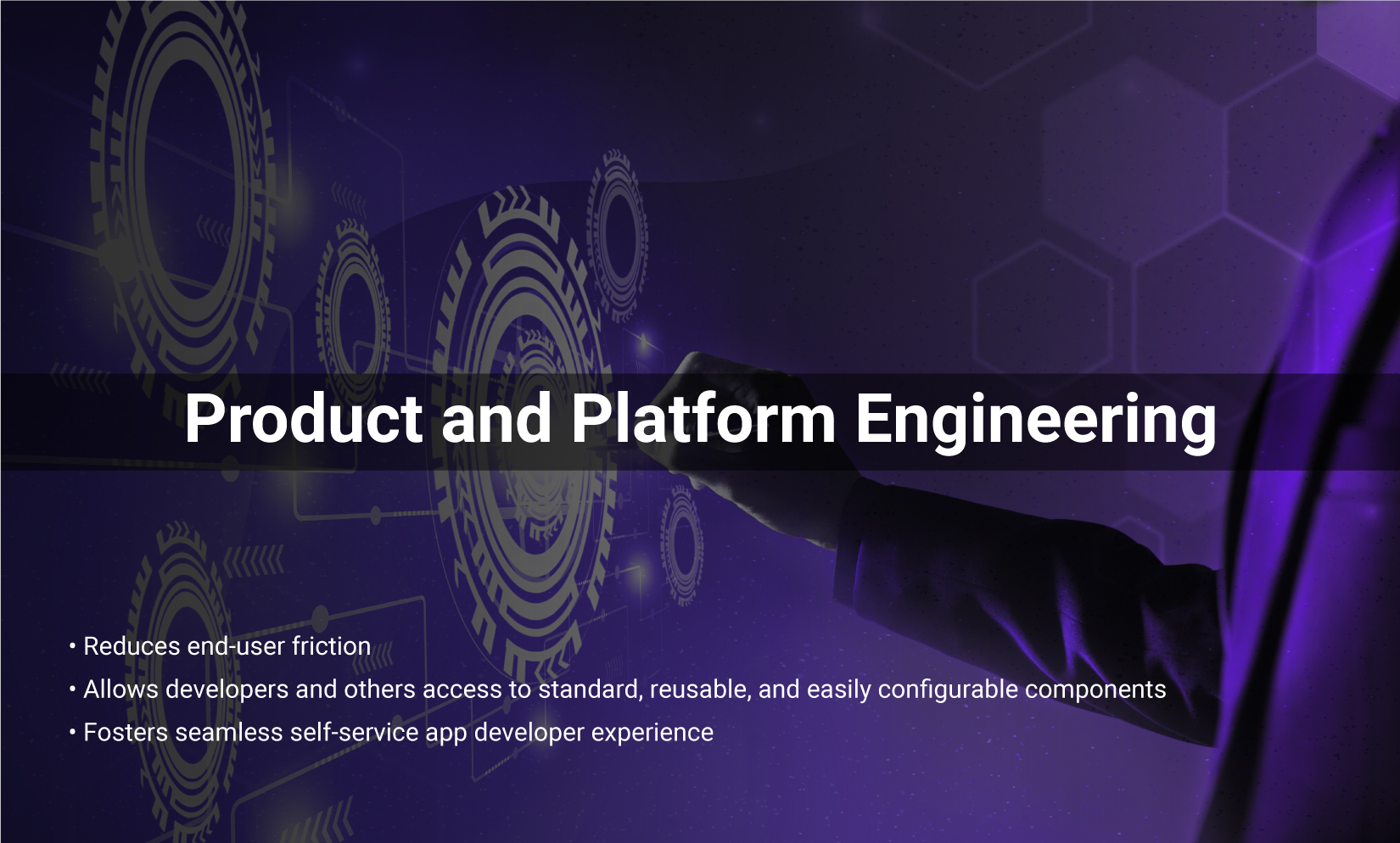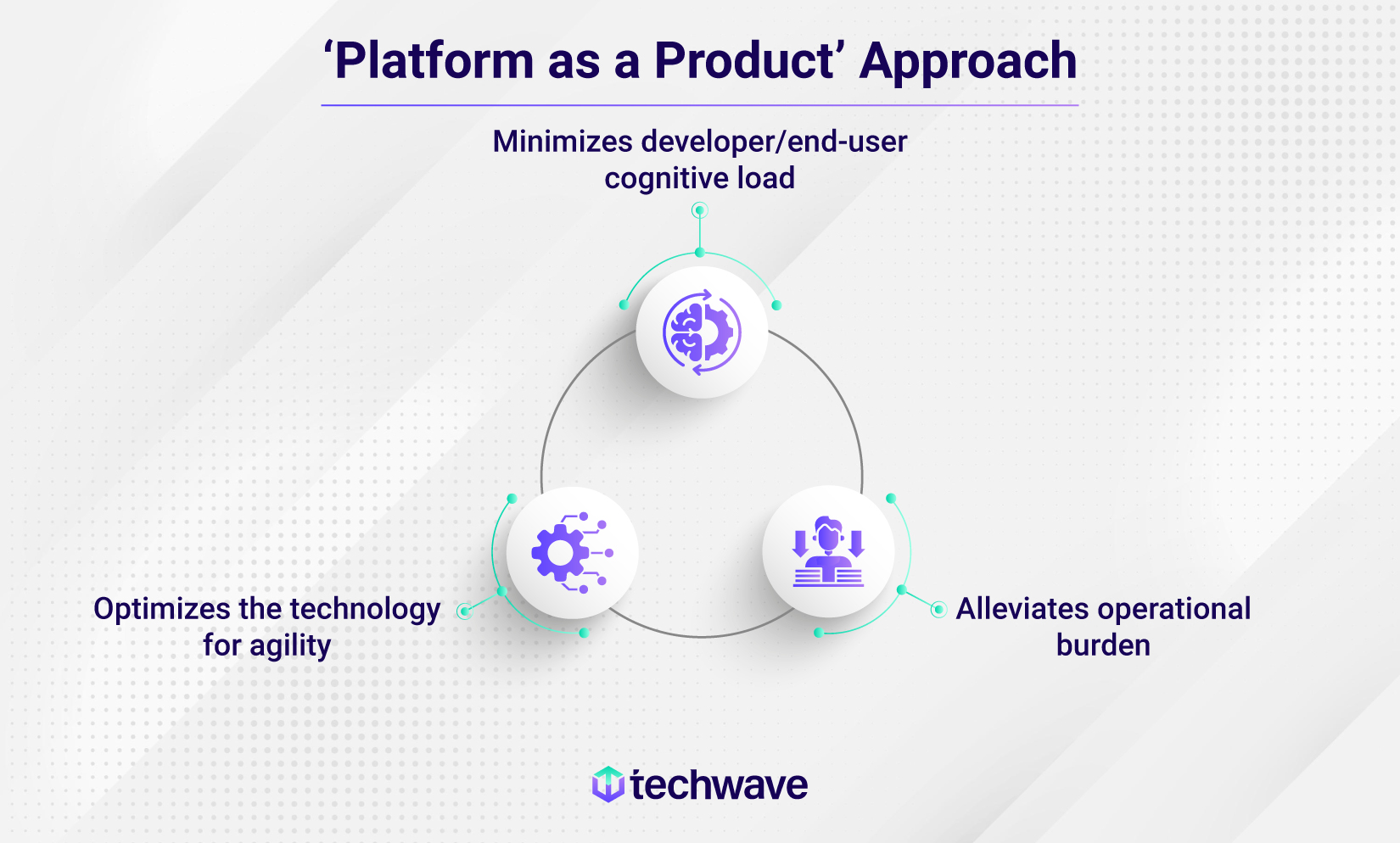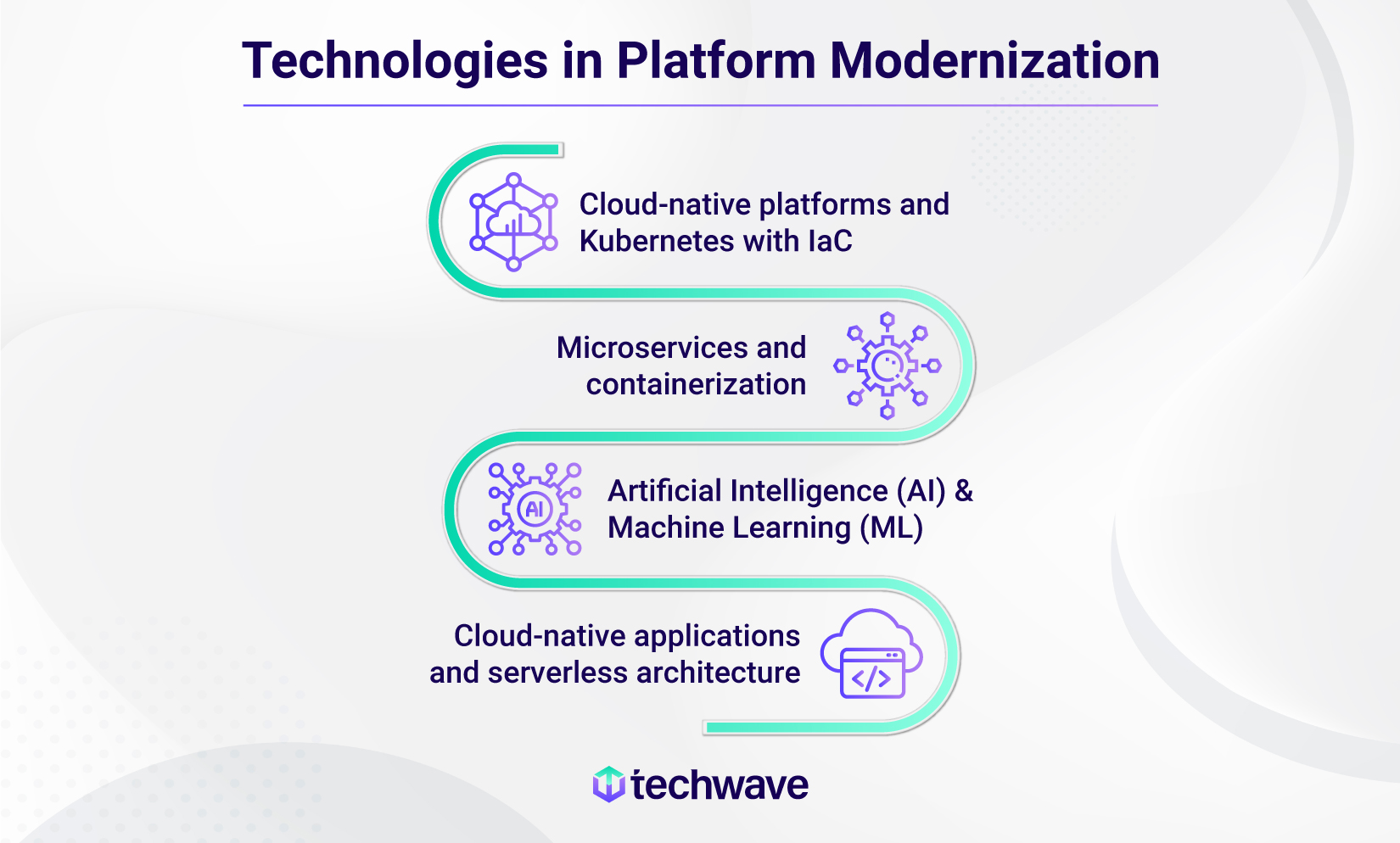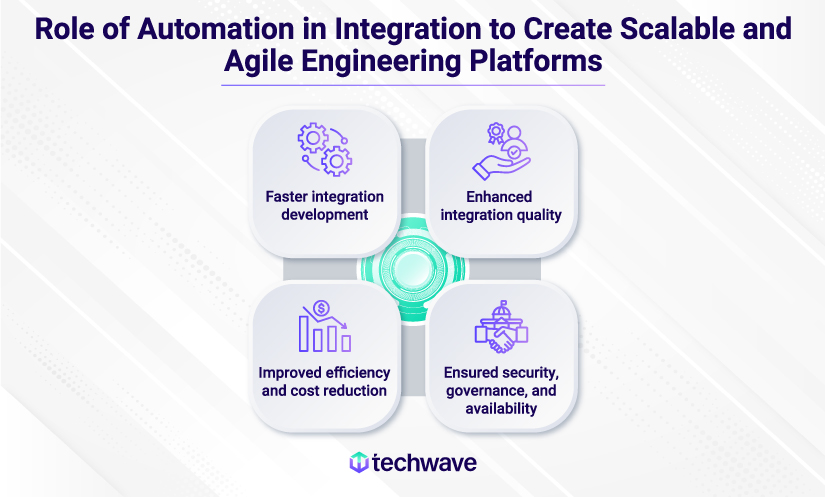The Emergence of Product and Platform Engineering

Platform Engineering marks the next stage after Agile DevOps but does not abandon the existing practices; instead, it seeks to combine the best aspects of both to create something distinct and compelling. According to a DevOps report, 94% of respondents concurred that platform engineering significantly enhances their organizations’ ability to fully leverage DevOps’s advantages.
Platform engineering is the go-to tool for accelerated and innovative product engineering – a process that involves managing the product’s life cycle, from ideation to the final deployment phase. In other words, platform engineering is building and maintaining the underlying infrastructure that supports product engineering. It is a complete package that emerged due to the growing need for end users to work on complex apps/software, regardless of their technical knowledge.

It is worth noting that a product generates revenue from a single transaction while a platform efficiently monetizes ongoing interactions.
For example, one can sell products on the Amazon e-commerce platform, share content on YouTube, or make apps for the IOS App Store. In each case, the platform gets a portion of the money from the sale.
In simple words, unlike a product, a platform is a continuous source of revenue where customers/end-users get what they want; hence, it makes sense to consider it a product too.
Platform Modernization: A Glimpse
As an emerging technology and with budget considerations, you may be on the fence about updating your infrastructure and build products on legacy systems that may work but will underperform.
Legacy systems carry significant risks:
- Challenges in updating systems with bug fixes, leading to workarounds and costly maintenance
- Higher security risks due to delayed updates and security patches
- Limited ability or slow response to adapt to changing market demands
Platform modernization, also known as legacy platform modernization or legacy app modernization, involves updating existing platforms to meet current standards and enable swift digital product development. This process includes upgrading infrastructure, architecture, and features to pave the way for future advancements.
However, it’s best to consult a platform expert or a product and platform engineering services provider to determine what to modernize and prioritize where to invest when everything looks like a nail! Platform modernization services offer several crucial benefits:
- Enhanced integrations and functionality of existing applications
- Scalability and improved performance
- Improved security measures
- Enhanced customer experience
- Increased revenue streams for businesses

Here are a few frontline technologies that facilitate platform modernization.
- Cloud-Native Platforms and Kubernetes with IaC: Initially, developers faced challenges with Kubernetes, such as complexity, security, performance optimization, etc., but improved tooling and platforms have made the process easier.
- Microservices and Containerization: Microservices ensure modularity and fault isolation for adapting to fast-paced business environments, while containers maximize resource utilization by running multiple isolated instances on shared infrastructure. Together, these technologies simplify platform modernization.
- Cloud-Native Applications and Serverless Architecture: Cloud-native applications built on serverless architecture allow small, dedicated teams to rapidly develop and deploy applications and workloads such as data processing, stream processing, and parallel processing without needing server setup and configuration. This approach promotes hardware decoupling and facilitates adding more components in parallel.
Role of Integration and Automation in Creating Scalable and Agile Platforms
Along with modernization, businesses must consider two critical platform features – agility and scalability to maximize PPE ROI. According to McKinsey, embracing enterprise agility can lead to a 20-30% improvement in financial performance and a 30-50% improvement in operational performance.
Achieving platform agility and scalability requires a strategic combination of integration and automation. It involves the integration of various technologies like microservices-based architectures, cloud technologies, IoT connectivity, data analytics, AI, and API integration with legacy systems. This allows organizations to respond swiftly to market changes, deliver superior products and platforms, and enhance customer experiences.
However, this integration presents challenges in managing various environments (e.g., development, testing, production) and handling extensive cloud resources. Organizations risk slowing down their development process and unnecessary errors without a well-established product and platform engineering practice.
To tackle these obstacles effectively, there is an urgent need for automation in the integration process.

APIs for Seamless Integration in Product and Platform Engineering
A question – how to bring about the integration and automation as mentioned above?
The answer – APIs
For example, you have a fabric business and are selling your products on the Amazon e-commerce platform alongside your company website. How would you streamline your operations so your sales, stock levels, customer reviews, etc., are consistent across both the e-commerce sites?
Amazon provides APIs (Application Programming Interfaces) that assist in managing and selling your products across both platforms.
For example, if you want to synchronize your inventory data, you can leverage the Amazon API for inventory synchronization across Amazon and your e-commerce site. This implies, when a product is sold on either platform, the API will update the inventory levels on both, avoiding overselling or running out of stock. Similarly, Amazon’s e-commerce platform offers APIs for Product Listing and Management, Order Processing, Shipping and Tracking, Reviews and Ratings, Customer Data and Insights, Promotions and Advertising, etc.
This integration saves you time and effort and enhances customer experiences by ensuring accurate and consistent information across platforms.
The follow-up question is – can we include third-party API integrations?
Yes, these third-party services are often referred to as middleware or integration platforms.
In the above example, the third-party application can be a payments app integrated with the Amazon e-commerce platform and the seller’s e-commerce website to allow a seamless payment experience for all parties (buyers, sellers, e-commerce platforms) involved in the transaction.
Businesses may often have unique requirements and need a more customized approach to API integration, particularly third-party API integrations. This is best possible with the help of an in-house platform team or a service provider.
Best Practices for Integrating Third-Party APIs into Product and Platform Engineering
A poorly executed API integration can lead to subpar application performance and a negative user experience. Here are a few best practices for third-party API integration, helping businesses create efficient and tailored product and platform engineering solutions for their needs.
- Refer to high-quality documentation: To fully utilize the capabilities of an API, referring to its documentation is essential. High-quality API documentation offers crucial information, including usage limitations, data input and output specifications, and other vital implementation details. It is a valuable guide for developers and users to maximize the API’s potential.
- Opt for well-tested and reliable APIs: It is vital to consider that APIs may face downtime, primarily when dependent on third-party services, resulting in an unsatisfactory user experience. To mitigate this risk, opting for well-tested APIs from reputed sources allows you to thoroughly test and manage your mission-critical applications, ensuring a robust user experience.
- Ensure API security: APIs from reputed sources like Amazon and Google often provide enhanced data protection through encrypted connections, ensuring higher security. On the other hand, poorly secured APIs can expose your business to potential security vulnerabilities. Given the increase in data theft and hacking incidents, choosing APIs that adhere to robust security policies is essential, fortifying your data against potential threats.
- The more scalable the API, the better: As businesses evolve, the need for adaptability becomes paramount. Opting for a scalable API allows it to expand alongside your business, ensuring you won’t need to revamp your existing third-party integrations when choosing flexible solutions. This scalability ensures a smoother transition and future-proofs your API integration efforts, accommodating your business’s growth without the burden of extensive rework.
- API Pricing makes a big difference: Given the complex pricing structure of APIs, many unsuspecting businesses end up paying more than expected for specific API usage they were unaware of. To avoid such situations, fully comprehending your chosen API’s pricing logic is essential. Take the time to estimate your expenses and compare them with the actual costs you incur. If you find a significant disparity between your estimates and actual spending, do not hesitate to contact your API provider. Seek information about your current price tier to clarify the pricing model and ensure you are well-informed about your API expenses.
Stay Ahead with Techwave’s Product and Platform Engineering Services
According to Gartner, by 2026, around 80% of software engineering organizations will create internal platform teams functioning as providers of reusable services, components, and tools for application delivery. Techwave’s Product and Platform Engineering team has expertise in efficiently abstracting away the complexities of creating and running innovative, customer-driven applications so that client-side developers can focus on creating fantastic new experiences instead of wasting time on infrastructure concerns.
Techwave product and platform engineering approach is based on the following:
- Platform-Led Innovation
- Human-Centered Design
- DevOps-Driven and Cloud-Native
You can leverage Techwave’s integration and automation services that make connecting and interfacing your platform with another easier. We build customized APIs and enable easy API integration with third-party services and systems by adhering to the best practices.
Read one of our success stories on how Techwave partnered with Cashé Software (a leading healthcare software supplier) to create, design, and host “Pavillio,” a healthcare management platform that transformed user experiences for the Home and Community-Based Services (HCBS) world. If it impresses you, please get in touch with us to learn how we can help you build similar cutting-edge engineering platforms.



